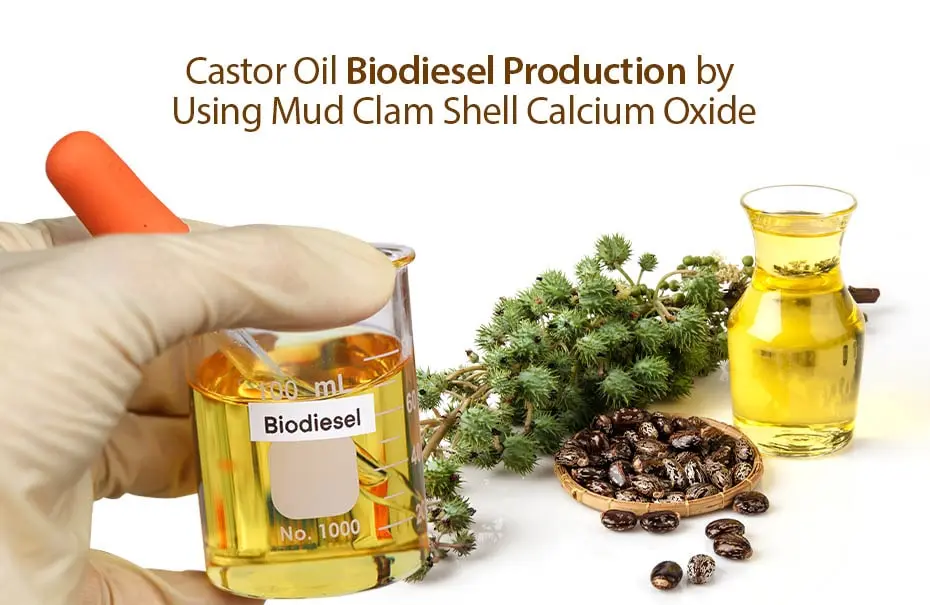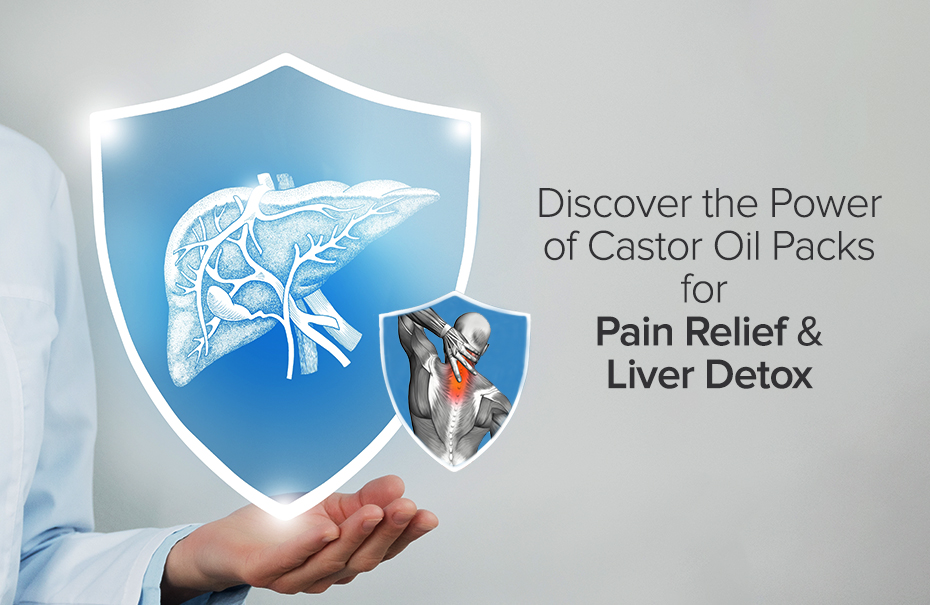Castor Oil Biodiesel Production by Using Mud Clam Shell Calcium Oxide

Castor oil never fails to surprise us with its outstanding ability to yield so many products among which, is one of the most promising fuels – Biodiesel, but, today in this article, we are going to see in detail how biodiesel is produced from castor oil using the calcium oxide derived from Mud Clam Shell as a catalyst.
We understand the whole topic appears to be pretty serious and confusing but don’t worry, let’s start by understanding what each term is and then will go through the process of it. So, here they are:
What is Biodiesel?
Biodiesel is a clean-burning alternative renewable fuel, similar to conventional diesel, that is derived mostly from oily plants like castor, soybean, or canola, as well as other oil-based sources like waste cooking fat from restaurants after deep-frying and animal fat/oils.
Due to its biodegradable nature, Biodiesel has found the greatest acceptance and is used as a replacement for fossil diesel fuel, usually blended with petroleum diesel fuel in various percentages.
Biodiesel and biodiesel blends are used in almost all diesel engines and vehicles and to use them no diesel engine modification is required to be done. It is safer to use and has low toxicity and exhaust emission rate compared to normal diesel fuel. But, the best feature of biodiesel among all is that it is a carbon-neutral liquid, which means that the combustion of biodiesel produces no net output of carbon in the form of carbon dioxide (CO2) like other mineral diesel.
What is Mud Clam Shell Calcium Oxide?
The mud clam is a bivalve (two-shelled species) just like mussels, oysters, and scallops, that lives on the mudflats in tidal areas, where it burrows deep into the mud with its muscular foot.
They are also called “soft shells” because their shells are very thin and can be easily broken and contain calcium carbonate in large amounts. Clams are harvested by digging them up and are relished by humans in various forms.
Now, the shells of mud clams are more valuable than you think because of their high calcium content. Hence, the mud clam shells are collected from a local supplier and all other possible sources, which is then washed with a 1% aqueous solution of sulfuric acid to remove dirt and stain on the shell surface. The cleaned shells are then ground to powder size which is then treated following hydrothermal treatment. The resulted shell powder is further thermally decomposed in the furnace at 800°C for 3 hours which is then refluxed and distilled for 24 hours.
At last, the shell powder is filtered, oven-dried at 120°C, and recalcined at 900°C for 2 hours using Humboldt muffle furnaces to produce fine calcium oxide. The collected calcium oxide is then stored in a sealed container to prevent contamination of carbonates and hydroxides.
Why the Need for Biodiesel is Growing?
We, humans, utilize so much energy in various forms in a single day, and to keep going, a continuous supply of energy is vital to support several human activities such as industrialization, transportation, and agriculture. But, with the depletion of fossil fuels and increasing demand for conventional energy globally which in fact is limited, there is a need to generate an alternative, nonconventional energy to support civilization and Biodiesel is one such significant alternative that we all need.
With many important technical advantages over conventional diesel, such as inherent lubricity, low toxicity, derivation from a renewable and domestic feedstock, superior flash point and biodegradability, negligible sulfur content, and lower exhaust emissions, biodiesel production is slowly becoming the need of the hour and pretty soon it may replace fossil fuels as a primary energy source for machinery and vehicles
How Biodiesel is Produced?
A chemical reaction is conducted to obtain biodiesel from tallow, vegetable oil or animal fat, and waste oils, and there are three stages of transformation of oil and fats to biodiesel and they are as follows:
- Base catalyzed transesterification of the oil
- Direct acid-catalyzed transesterification of the oil
- Conversion of the oil to its fatty acids followed by biodiesel
Although among the three, base-catalyzed transesterification is the most used and economical process as it requires low temperatures and pressures and produces a 98% conversion yield.
Transesterification of Castor Oil Using Mud Clam Shell Catalyst
Transesterification is a chemical reaction of a triglyceride (fat/oil) with an alcohol to form esters and glycerol. Now, the triglyceride has a glycerine molecule as its base with three long-chain fatty acids attached and the characteristics of those fats are determined by the nature of the fatty acids attached to the glycerine which can, in turn, affect the characteristics of the biodiesel.
During the process, the R group of an alcohol is exchanged with an R’ group of an ester which is generally done via the introduction of an acid or base catalyst to the reaction mixture to convert natural fats and oils into Fatty Acid Methyl Esters (FAME) or Biodiesel.
Some of the suitable oils (to make biodiesel) come from crops like palm, soybean, or rapeseed but despite having high viscosity compared to other vegetable oils, castor proves to be a promising source of feedstock for biodiesel production because sulfur is absent in it; and it has greater cetane number which indicates a better quality of ignition and more oxygen content which promote more complete combustion than others. Moreover, the lubricity of castor oil is way better than other oils having similar carbon chain-length fatty acids.
Due to the high content of ricinoleic acid in castor oil, its hydroxylated fatty acids impart better performance which makes castor oil the best vegetable oil to carry out the transesterification process for biodiesel production.
Now, for transesterification of castor oil, both homogeneous and heterogeneous catalysts can be used but studies show that transesterification of castor oil with heterogeneous catalysts is much better than homogeneous because they can be readily separated, regenerated, and recycled. They have a long life and fewer purification step and lower selectivity. Also, heterogeneous base catalysts reduce the cost of biodiesel production by eliminating the need for acid neutralization and water removal like in homogenous base catalysts.
During the transesterification of castor oil, the triglyceride molecule is reacted with alcohol in the presence of a catalyst. Further, the alcohol reacts with the fatty acids and forms the mono-alkyl ester, or biodiesel and crude glycerol. Methanol or ethanol is the commonly used alcohol in biodiesel production and is base-catalyzed by either potassium or sodium hydroxide.
Several experiments have been conducted using different catalysts to check the biodiesel yield but for transesterification of castor oil, using calcium oxide as the heterogeneous catalyst, caught researchers’ attention because it is cheap and abundantly available in nature as limestone and also from sea shells like mud clams in the form of calcium carbonate, CaCO3.
Mud clam shell-catalyzed transesterification of castor oil is no different than other transesterification processes, only that the base catalyst is calcium oxide obtained from mud clamshells, set to optimal parameters for the highest biodiesel yield. The only difference is that the calcium oxide can be reused. The used catalyst is separated from the reaction mixture by centrifugation and washed with n-hexane to remove any impurities and is further dried and recalcined at 900°C for reutilization.
Also, the castor oil used in it is crude castor oil which is extracted from the castor bean using Soxhlet extraction with hexane as a solvent. In order to reduce the free fatty acid content of the crude castor oil to less than 0.5%, the collected oil is degummed with aqueous sulfuric acid and pretreated with acid esterification.
What Makes Calcium Oxide the Suitable Catalyst?
To obtain the highest yield of biodiesel, the physical and chemical properties of the synthesized catalyst such as its microstructure, particle surface area, and infrared absorption patterns are to be studied and the optimum parameters for transesterification of castor oil such as reaction time, temperature, the molar ratio of oil to the alcohol, and catalyst concentration are investigated and noted down.
Calcium Oxide was found to be suitable for large-scale production of biodiesel for commercial purposes by all means. It is not only easily available but is very economical because it can be reused up to 3 times in a transesterification reaction. In addition to that, as it is derived from a natural source, it is environmentally friendly. It even needs no post treatment prior to its disposal to the environment and hence causes no harm to the ecosystem.
Conclusion
Castor biodiesels can be obtained directly from raw oil but it is expensive and so a majority of biodiesel production is carried from waste and used oil which is actually good for the environment too. Whatever the case may be, biodiesel is emerging as one of the most potential renewable energy, and with the way its demand is growing, it will soon replace current petrol-derived diesel.



